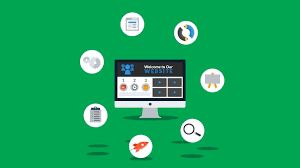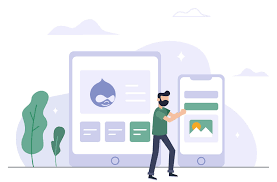Web Design: The Importance of a Great Website
In today’s digital age, having a strong online presence is essential for any business or organization. And at the heart of that online presence is a great website. A well-designed website can make all the difference in attracting and retaining customers, building brand awareness, and ultimately driving sales.
So what exactly is web design? In simple terms, it refers to the process of creating and designing websites. This includes everything from the layout and structure of the site to its overall look and feel. But web design isn’t just about aesthetics – it’s also about functionality and user experience.
Here are just a few reasons why web design is so important:
First Impressions Matter
Your website is often the first point of contact between your business and potential customers. And as we all know, first impressions matter. A poorly designed website can turn visitors off before they even have a chance to explore your products or services. On the other hand, a well-designed site can grab their attention and keep them engaged.
User Experience Is Key
A good website isn’t just about looking pretty – it’s also about providing a great user experience. This means making sure that your site is easy to navigate, loads quickly, and provides relevant information in an organized way. A positive user experience can lead to increased engagement, repeat visits, and ultimately more conversions.
Brand Awareness
Your website is an extension of your brand – it should reflect your values, personality, and mission. A well-designed site can help you build brand awareness by creating a consistent look and feel across all of your online channels. This includes using consistent colors, fonts, imagery, and messaging.
SEO Benefits
Good web design isn’t just about aesthetics – it can also impact your search engine rankings. Search engines like Google take into account factors like page load speed, mobile responsiveness, and user experience when ranking websites in search results. So if you want to improve your SEO, investing in quality web design is a must.
In conclusion, web design is an essential component of any successful online presence. A well-designed website can help you attract and retain customers, build brand awareness, and improve your search engine rankings. So if you’re looking to enhance your online presence, investing in quality web design is a smart move.
Answers to Common Questions About Web Design
- What does a web designer do?
- What are the 3 types of web design?
- Can I teach myself web design?
- How do I start web designing?
What does a web designer do?
A web designer is responsible for designing and creating websites. They work closely with clients to determine their needs and objectives, and then use their technical and creative skills to bring those ideas to life.
Some of the key responsibilities of a web designer include:
- Designing the layout and structure of the website: This includes determining how the site will be organized, what pages will be included, and how users will navigate through the site.
- Creating visual elements: Web designers are responsible for creating images, graphics, and other visual elements that will be used on the website.
- Developing a color scheme: Web designers choose a color scheme that is consistent with the client’s brand identity.
- Writing code: Web designers use HTML, CSS, JavaScript or other programming languages to build the website.
- Testing the website: Web designers test every element of the website to ensure it functions properly across different browsers and devices.
- Maintaining the website: After launching a website, web designers may continue to maintain it by updating content or making changes to its design.
Overall, a web designer plays a crucial role in creating an effective online presence for businesses or organizations. They must have a strong understanding of both design principles and coding languages in order to create websites that are visually appealing, user-friendly, and functional on all devices.
What are the 3 types of web design?
The three types of web design are:
Responsive Web Design: This type of web design involves creating a website that can adjust to different screen sizes and devices, such as desktops, laptops, tablets, and smartphones. With responsive design, the layout and content of the website will adapt to fit the size of the screen it is being viewed on.
Adaptive Web Design: This type of web design involves creating multiple versions of a website for different screen sizes and devices. Unlike responsive design, which uses a single layout that adapts to different screens, adaptive design uses predefined layouts for each device size.
3. Static Web Design: This type of web design involves creating a website with fixed content that does not change unless it is manually updated by the developer. Static websites are typically used for simple sites with few pages or for sites that don’t require frequent updates. They are easy to create and maintain but may not be suitable for more complex websites or those that require frequent updates.
Can I teach myself web design?
Yes, you can definitely teach yourself web design! With the abundance of online resources available, it’s easier than ever to learn web design on your own. Here are some steps you can take to get started:
- Set Your Goals: Before you begin, it’s important to define what you want to achieve with web design. Do you want to create a personal website? Or are you looking to build a career in web design? Having clear goals will help guide your learning process.
- Learn the Basics: Start by learning the basics of HTML and CSS. These are the building blocks of web design and will give you a solid foundation for more advanced topics.
- Practice, Practice, Practice: The best way to learn web design is by doing it yourself. Create your own projects and experiment with different techniques and styles.
- Use Online Resources: There are many online resources available for learning web design, including tutorials, courses, forums, and blogs. Some popular resources include Codecademy, W3Schools, and Udemy.
- Join a Community: Joining a community of like-minded individuals can be incredibly helpful in learning web design. Look for local meetups or online communities where you can connect with other designers and get feedback on your work.
- Stay Up-to-Date: Web design is constantly evolving, so it’s important to stay up-to-date with the latest trends and technologies. Follow industry blogs and social media accounts to stay informed.
In conclusion, teaching yourself web design is definitely possible with dedication and hard work. By setting clear goals, learning the basics, practicing regularly, using online resources, joining a community, and staying up-to-date with industry trends, you can become a skilled web designer in no time!
How do I start web designing?
Starting web designing can seem daunting, but it doesn’t have to be! Here are some steps you can take to start your journey in web design:
- Learn the basics: Start by learning the basics of HTML, CSS, and JavaScript. These are the building blocks of web design and will give you a good foundation to work from.
- Choose your tools: There are many tools available for web design, including text editors, graphic design software, and content management systems (CMS). Choose the tools that work best for you and your needs.
- Study design principles: Good web design is about more than just coding – it’s also about aesthetics and user experience. Study design principles such as color theory, typography, and layout to create visually appealing and user-friendly websites.
- Practice, practice, practice: The best way to improve your skills in web design is through practice. Start by creating simple websites or redesigning existing ones to get a feel for how things work.
- Get feedback: Share your designs with others and ask for feedback. This can help you identify areas where you need improvement and give you ideas for new projects.
- Keep learning: Web design is constantly evolving, so it’s important to keep up with the latest trends and technologies. Attend workshops or online courses to stay up-to-date on the latest developments in web design.
Remember that starting out in web design takes time and effort – but with dedication and practice, you’ll soon be on your way to creating beautiful and functional websites!




